
- Home
- Hemingray 101
Fakes & Reproductions

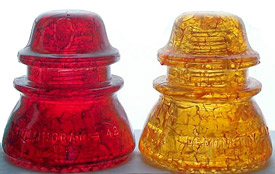
"Crackle glass" is a term used to describe insulators that have been intentionally heated up and then immediately cooled, causing internal fractures in the glass. These insulators (often clear) are then frequently painted or stained with bright colors such as red, yellow, blue, etc. Clear Hemingray insulators are the most common targets of this practice because they were made in such abundance. These insulators are basically destroyed and consequently have little to no monetary value.

Commonly seen on eBay and Etsy, clear Hemingrays are painted or stained vibrant colors, such as bright yellow, red, blue, violet, etc. Some even have 2 or 3 colors all on the same insulator. One of the easiest ways to tell if a color is fake is to check the embossing. If the insulator has a mold and date code, it was produced after 1933 and therefore after Hemingray stopped making brightly colored glass (with the exception of amber and carnival) and therefore it's a fake color. All of the insulators pictured were originally clear and have been stained or painted.
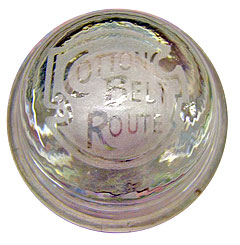
Hemingray insulators have been found on eBay with sandblasted or etched logos in the glass, such as the dome of this CD 122. Presumably, these were intended to be souvenirs, commemorating whichever line or area they were found on. Whether these insulators truly came from those lines is anybody's guess. However, one thing is for certain: these sandblasted/etched logos are not original to the insulator and so it is considered to be an altered piece.
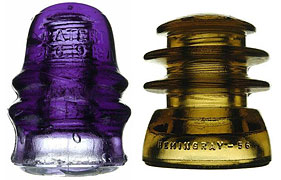
Some insulators are exposed to radiation to alter their color. While less commonly seen in Hemingray insulators, they do exist, so be warned. Two such examples are pictured here. Please visit the NIA web site for more photos of irradiated insulators (see links below). Note specifically the insulators manufactured by Hemingray, including the ones labeled "H.G.CO." and "Dec 19 Pat".
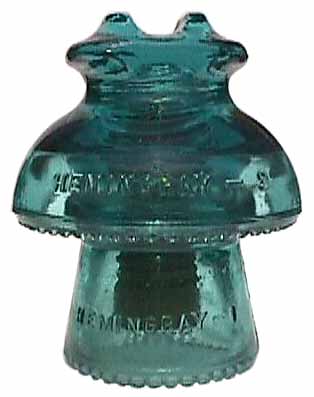
Sometimes, people will cut insulators apart, or put mismatching pieces together to make a completely new fantasy insulator (or what I like to call a "Frankensteinsulator"). One such example pictured above (photo credit Insulators.info), is nicknamed the "Baby Muncie" because it resembles a miniature version of a CD 303/310 Muncie Type. It consists of two real Hemingray insulators: the bottom piece is a CD 122 Hemingray-16 with the top cut off at the wire groove; the top piece is a CD 241 Hemingray-23. On some examples, they will even file off the trailing numbers, leaving only "Hemingray-1" and "Hemingray-2". This is just one example; there are many other types of fantasy insulators that have shown up over the years, which can be seen at Insulators.info.
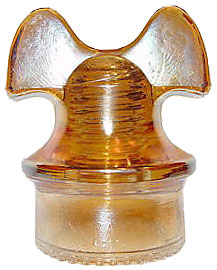
Hemingray produced many styles of insulators with a carnival glass coating, typically within the period of 1932-1936. However, there have been at least a couple of styles (most notably the CD 257 "Mickey Mouse", shown here) that had this carnival coating applied to them after they were manufactured. It's not always easy to tell a legitimate carnival from a fake one, but here are a couple of tips:
For more thorough information on real versus fake carnival glass Hemingrays, I would encourage you to read Mike Guthrie's Handbook for the Recognition and Identification of Fake, Altered and Repaired Insulators, Section 2.

An "insulcat" is an insulator that has been reheated and then stretched and reshaped to give it features that vaguely resemble a cat. Sometimes they will glue "googly eyes" and/or whiskers onto the head to make it look more like a cat. These are typically made out of common clear Hemingray insulators (such as Hemingray CD 122, 154 or 155), but aqua insulators have been used as well, such as the example shown here. Aside from being a novelty or folk art piece, these have little value. This would be considerd a form of both heat- and mechanically-induced alteration.

More recently, lamps using Hemingray insulators as shades/covers have grown a lot in popularity. These insulators have a hole drilled through the top into the pinhole, and the pinhole is used to house the light bulb and socket. Typically, clear and aqua Hemingray insulators of many different styles are being used.
Many different styles of lamps are being produced, including wall sconces, steampunk table lamps, and ceiling hanging lamps. While these make a neat conversation piece and are a great example of "upcycling" for insulators, the insulators themselves are considered to be mechanically altered due to the drilled hole.
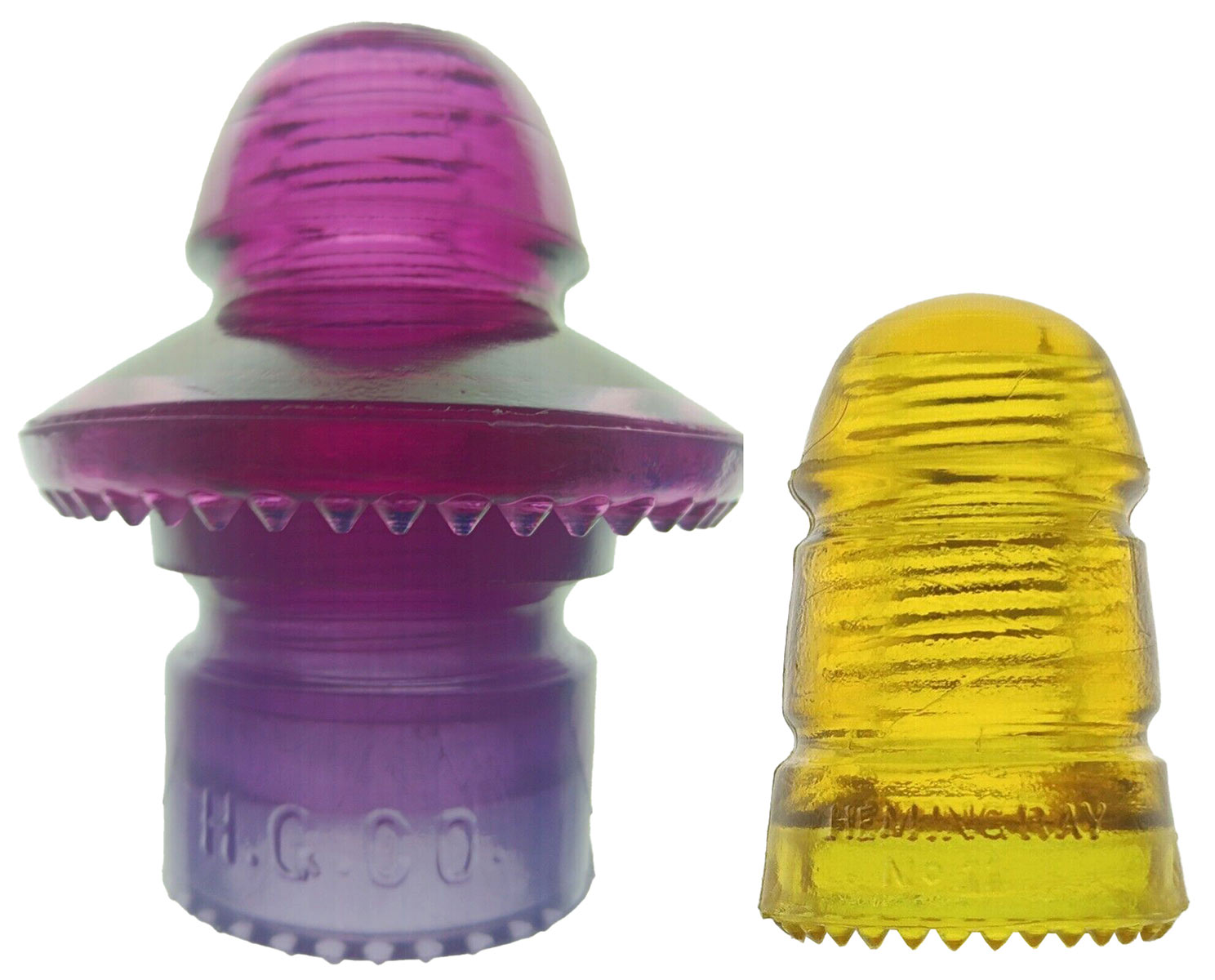
Resin reproductions of real insulators have been made over the years, and were originally called "impostulators" in the 1990s. In person, they are fairly easy to identify by holding them, as they are lighter weight than glass. Also, they are often made in fantasy colors that don't exist in the real glass specimens. Most are marked as reproductions on either the bottom of the skirt or inside. Most recently, resin reproductions have been produced by Nick Norwood and bear the marking "REPRO NN 2024" inside the pinhole. Known Hemingray reproductions include CD 100, 114, 196, and 257.

More recently, 3D printed insulators have begun to be produced as well, often of rare styles to act as placeholders for those who are looking to add them to their collections. It is unknown if they are permanently marked as reproductions in accordance with NIA requirements. Known Hemingray reproductions currently include CD 124.5, 155.6, and 280.1 (misspelled "HEMINGREY" as pictured). They are sold on eBay by seller ssnyder2012.
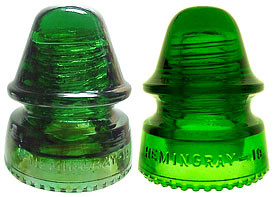
The "NAJ" full size reproduction (left) is modeled directly after the popular Hemingray 19 (CD 162) insulator (right). It has been assigned the Special Issue number SI 162-3.875. In December 2004, Eric Johnson of Stuart, Florida had this mold made. These insulators come in a rainbow of colors, some of which are very similar to authentic Hemingray colors. The earliest versions are either unmarked or have "NAJ-03" or "NAJ-04" etched into the glass, prompting the NIA to issue a special notice about this reproduction. Later versions are embossed with "NAJ 2005" to prevent them from being mistaken for authentic pieces. They have been made with both RDP (round drip points) and SDP (sharp drip points) with full size threads, and also in solid pours. The easiest way to identify a NAJ reproduction is to examine the crown: it has a conical, straight-sided crown that is not typical of authentic Hemingrays. Also, the embossing is generally fainter than typically found. Compare the two pieces above.
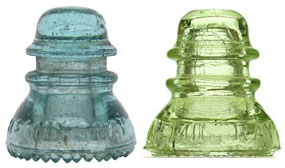
An original salesman sample is pictured on the left, above. Hemingray produced miniature salesman samples in the 1920's-1930's, some of which were given out at the 1933 World's Fair Century of Progress Exhibition. They are essentially tiny, 1-inch-high replicas of the CD 154. Originals are only known to come in 3 colors: Aqua, 7up Green, and Amber. Originals have a strong embossing: (F-Skirt) HEMINGRAY (R-Skirt) U.S.A. and have tiny, sharp drip points. Reproductions of these pieces are abundant, coming in a rainbow of colors. They are known to be manufactured by three different glass works: Boyd Art Glass of Cambridge, Ohio; Fred Wilkerson of Moundsville, West Virginia; and Larry S. Veneziano of West Chicago, Illinois. Embossings on the reproduction pieces are typically weak, the drip points aren't as articulate, and the glass surface often shows striations.
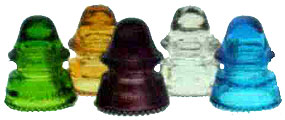
This special issue miniature is not technically a reproduction, since it is not molded from any known Hemingray salesman miniature. However, since these are embossed with the "Hemingray" embossing, they have been noted here. These are a miniature version of the CD 162 style, produced by John and Carol McDougald of Sedona, Arizona. They were produced in the following colors: 7up Green, Amber, Clear, Cobalt Blue, Hemingray Blue, Purple, and Silver Carnival.
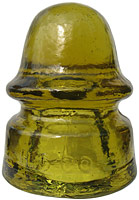
Created in 2010 by Mark Lauckner of the Mayne Island Glass Foundry and Museum, British Columbia, this full size commemorative is modeled after the CD 162, and is embossed (F-Skirt) H.G.CO. (R-Skirt) PETTICOAT. The piece is also embossed on the base with either "Lauckner 2010" or "IBEW LOCAL 44 50 YEARS", and has no internal threading. These have been produced in many different colors.
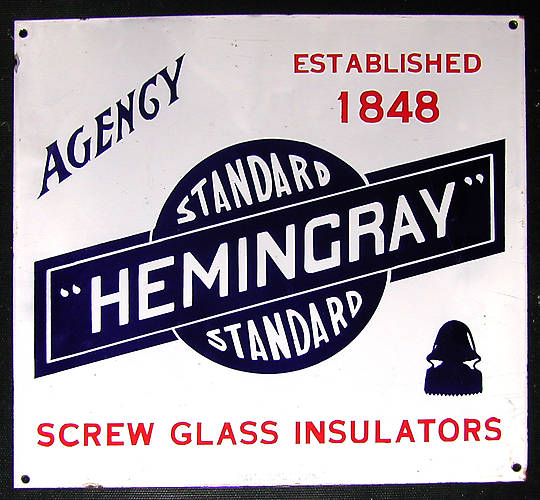
While this isn't an insulator, it should definitely be noted here. So far I've seen about 6 or so of these signs being sold online over the years (primarily on eBay). They measure approximately 15" x 14". There are two styles known:
Personally, I strongly doubt the authenticity of both sign styles for the following reasons: